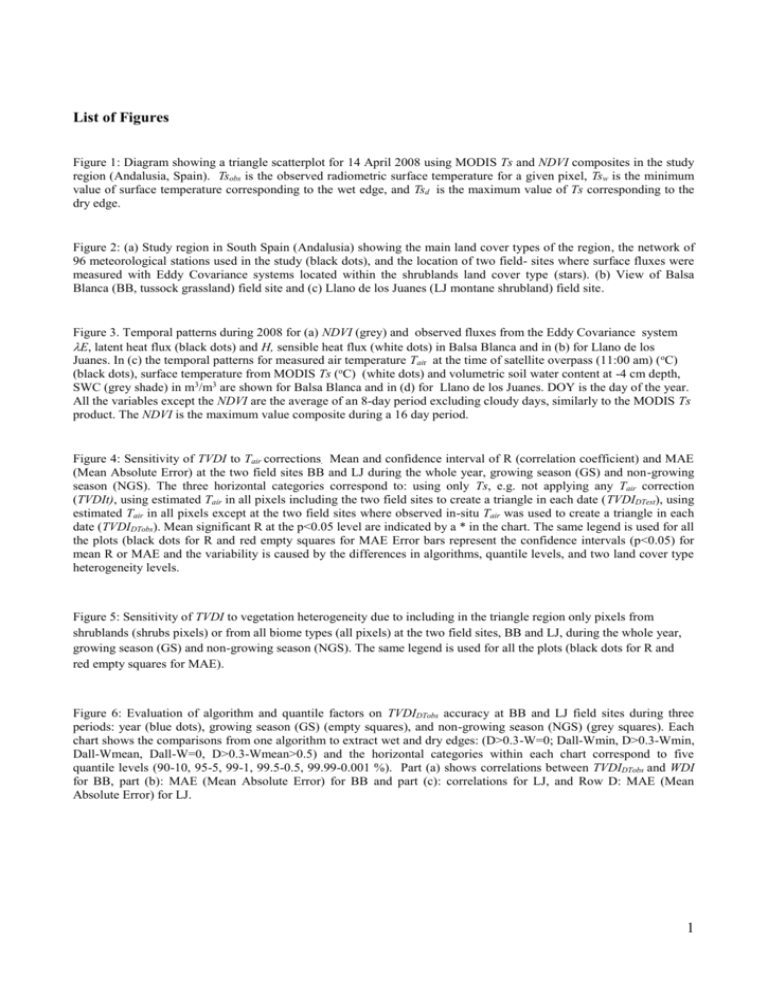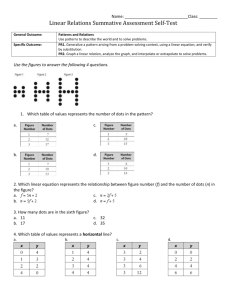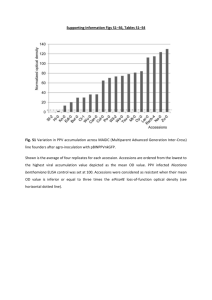List of Figures Figure 1: Diagram showing a triangle scatterplot for
advertisement

List of Figures Figure 1: Diagram showing a triangle scatterplot for 14 April 2008 using MODIS Ts and NDVI composites in the study region (Andalusia, Spain). Tsobs is the observed radiometric surface temperature for a given pixel, Tsw is the minimum value of surface temperature corresponding to the wet edge, and Tsd is the maximum value of Ts corresponding to the dry edge. Figure 2: (a) Study region in South Spain (Andalusia) showing the main land cover types of the region, the network of 96 meteorological stations used in the study (black dots), and the location of two field- sites where surface fluxes were measured with Eddy Covariance systems located within the shrublands land cover type (stars). (b) View of Balsa Blanca (BB, tussock grassland) field site and (c) Llano de los Juanes (LJ montane shrubland) field site. Figure 3. Temporal patterns during 2008 for (a) NDVI (grey) and observed fluxes from the Eddy Covariance system E, latent heat flux (black dots) and H, sensible heat flux (white dots) in Balsa Blanca and in (b) for Llano de los Juanes. In (c) the temporal patterns for measured air temperature Tair at the time of satellite overpass (11:00 am) (oC) (black dots), surface temperature from MODIS Ts (oC) (white dots) and volumetric soil water content at -4 cm depth, SWC (grey shade) in m3/m3 are shown for Balsa Blanca and in (d) for Llano de los Juanes. DOY is the day of the year. All the variables except the NDVI are the average of an 8-day period excluding cloudy days, similarly to the MODIS Ts product. The NDVI is the maximum value composite during a 16 day period. Figure 4: Sensitivity of TVDI to Tair corrections. Mean and confidence interval of R (correlation coefficient) and MAE (Mean Absolute Error) at the two field sites BB and LJ during the whole year, growing season (GS) and non-growing season (NGS). The three horizontal categories correspond to: using only Ts, e.g. not applying any Tair correction (TVDIt), using estimated Tair in all pixels including the two field sites to create a triangle in each date (TVDIDTest), using estimated Tair in all pixels except at the two field sites where observed in-situ Tair was used to create a triangle in each date (TVDIDTobs). Mean significant R at the p<0.05 level are indicated by a * in the chart. The same legend is used for all the plots (black dots for R and red empty squares for MAE Error bars represent the confidence intervals (p<0.05) for mean R or MAE and the variability is caused by the differences in algorithms, quantile levels, and two land cover type heterogeneity levels. Figure 5: Sensitivity of TVDI to vegetation heterogeneity due to including in the triangle region only pixels from shrublands (shrubs pixels) or from all biome types (all pixels) at the two field sites, BB and LJ, during the whole year, growing season (GS) and non-growing season (NGS). The same legend is used for all the plots (black dots for R and red empty squares for MAE). Figure 6: Evaluation of algorithm and quantile factors on TVDIDTobs accuracy at BB and LJ field sites during three periods: year (blue dots), growing season (GS) (empty squares), and non-growing season (NGS) (grey squares). Each chart shows the comparisons from one algorithm to extract wet and dry edges: (D>0.3-W=0; Dall-Wmin, D>0.3-Wmin, Dall-Wmean, Dall-W=0, D>0.3-Wmean>0.5) and the horizontal categories within each chart correspond to five quantile levels (90-10, 95-5, 99-1, 99.5-0.5, 99.99-0.001 %). Part (a) shows correlations between TVDIDTobs and WDI for BB, part (b): MAE (Mean Absolute Error) for BB and part (c): correlations for LJ, and Row D: MAE (Mean Absolute Error) for LJ. 1 Figure 7: (a) Correlations (R), (b) MAE (Mean Average Error) and (c) bias between the best performing TVDI algorithm and field estimates of WDI for BB and LJ together (excluding the period of radiation control in LJ). DTest (green inverted triangle) shows results for TVDIDTest , dark green triangle shows DTest filtered by a threshold of R2>0.75 in accuracy of Tair maps, DTobs (brown dots) shows results for TVDIDTobs, orange dots-dashed line shows TVDIDTobs filtered by a threshold of R2adj >0.75 in accuracy of Tair maps. Figure 8: Observed sensible heat flux (H) and latent heat flux (E) with EC data vs. H and E derived from TVDI DTobs algorithm D>0.3-W=0, quantile 99.5-0.5% at BB (triangles) and LJ (squares). The 1:1 line is represented. Figure 9: Temporal correlation (Pearson) between TVDIDTobs errors in BB and LJ with variables indicating climatic heterogeneity in the triangle region. The coefficient of variation, CV, in each date of 2008 from 96 meteorological stations data (see Figure 1) was used as an index of spatial heterogeneity in the region, therefore is the same for both LJ and BB sites. The variables evaluated were: the CV of relative humidity (RH%), the CV of wind speed (WS), the CV of potential E (Ep), and the CV of air temperature (Tair). Two variables indicating errors in spatial interpolation of Tair in the triangle region were also evaluated: MAPE%-Tair (Mean Absolute Percentage Error, %) and R2adj-Tair (accuracy of spatial patterns) for each date of 2008. The TVDIDTobs error was the difference between TVDIDTobs and field estimates of WDI in each date. Asterisks indicates significant correlations (p<0.05). Sample sizes were n=29 (BB) and n=22 (LJ). Results were derived from algorithm TVDIDTobs D>0.3-W=0, quantile 95.0% -5%. The embedded table shows the annual mean and standard deviation (std) of the CV during 2008 for the climatic variables evaluated. APPENDIX Figure A.1. Validation results in 2008 of the spatial interpolations of Tair maps (8-day time scale). (n=44 dates). The black dots show the accuracy of spatial patterns for each date (R2adj) and the grey area the RMSE errors. Correlations were significant (p<0.05) at all dates except at DOY 72 with p=0.065. 2








